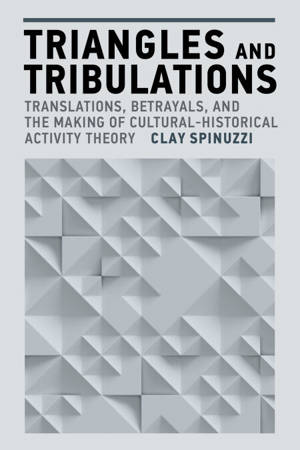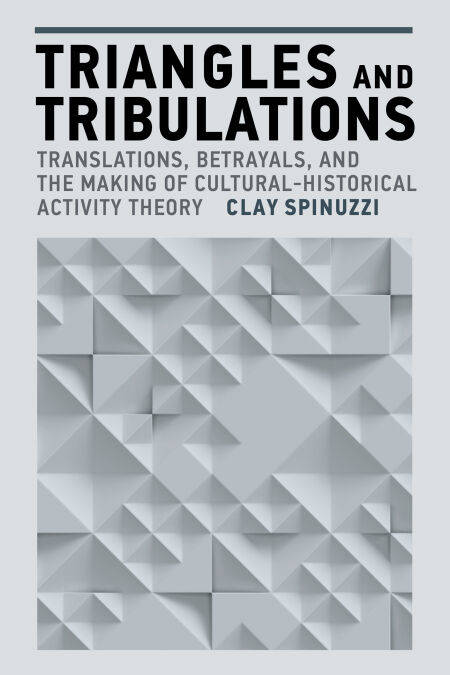
- Afhalen na 1 uur in een winkel met voorraad
- Gratis thuislevering in België vanaf € 30
- Ruim aanbod met 7 miljoen producten
- Afhalen na 1 uur in een winkel met voorraad
- Gratis thuislevering in België vanaf € 30
- Ruim aanbod met 7 miljoen producten
Zoeken
Triangles and Tribulations E-BOOK
Translations, Betrayals, and the Making of Cultural-Historical Activity Theory
Clay Spinuzzi
€ 64,07
+ 64 punten
Omschrijving
How the sociology of translation can help us understand a social science framework—cultural-historical activity theory (CHAT)—as a set of uneasy settlements that both further and betray their original intentions.
How do social science frameworks get taken up and spread? In Triangles and Tribulations, Clay Spinuzzi uses the sociology of translation to reread the history of one such framework, cultural-historical activity theory (CHAT). CHAT originated in the 1920s and 1930s work of Soviet psychologists in the Vygotsky Circle, with its key insight—mediation—depicted in a simple triangular diagram drawn by Lev Vygotsky. From there, CHAT was developed and popularized by international scholars, including Finnish researcher Yrjö Engeström, who used Vygotsky's triangle as a basis for his own. Through this progressive development, CHAT carried on the work of its forebears, building on their foundations—or so we are sometimes encouraged to understand these transformations.
But each such translation, Spinuzzi argues, is also a betrayal: Each innovation opens new possibilities for CHAT but also disrupts a previous settlement. Examining specific points in CHAT's history, Spinuzzi reviews how CHAT has been applied to different domains, in service to different projects, and evaluated through different trials, undergoing rhetorical transformations. These translations, sedimented as a series of settlements, have allowed it to persist as a social science approach and develop as a framework for workplace studies. But they have also involved accumulating concepts and terms from various social sciences, yielded radical changes in scope, and led to ongoing disputes about what constitutes its unit(s) of analysis. In examining CHAT's triangles, Spinuzzi considers how social science frameworks live through practice and dialogue so that they can continue becoming meaningful to others.
How do social science frameworks get taken up and spread? In Triangles and Tribulations, Clay Spinuzzi uses the sociology of translation to reread the history of one such framework, cultural-historical activity theory (CHAT). CHAT originated in the 1920s and 1930s work of Soviet psychologists in the Vygotsky Circle, with its key insight—mediation—depicted in a simple triangular diagram drawn by Lev Vygotsky. From there, CHAT was developed and popularized by international scholars, including Finnish researcher Yrjö Engeström, who used Vygotsky's triangle as a basis for his own. Through this progressive development, CHAT carried on the work of its forebears, building on their foundations—or so we are sometimes encouraged to understand these transformations.
But each such translation, Spinuzzi argues, is also a betrayal: Each innovation opens new possibilities for CHAT but also disrupts a previous settlement. Examining specific points in CHAT's history, Spinuzzi reviews how CHAT has been applied to different domains, in service to different projects, and evaluated through different trials, undergoing rhetorical transformations. These translations, sedimented as a series of settlements, have allowed it to persist as a social science approach and develop as a framework for workplace studies. But they have also involved accumulating concepts and terms from various social sciences, yielded radical changes in scope, and led to ongoing disputes about what constitutes its unit(s) of analysis. In examining CHAT's triangles, Spinuzzi considers how social science frameworks live through practice and dialogue so that they can continue becoming meaningful to others.
Specificaties
Betrokkenen
- Auteur(s):
- Uitgeverij:
Inhoud
- Aantal bladzijden:
- 316
- Taal:
- Engels
- Reeks:
Eigenschappen
- Productcode (EAN):
- 9780262382786
- Verschijningsdatum:
- 16/06/2025
- Uitvoering:
- E-book
- Beveiligd met:
- Adobe DRM
- Formaat:
- ePub

Alleen bij Standaard Boekhandel
+ 64 punten op je klantenkaart van Standaard Boekhandel
Beoordelingen
We publiceren alleen reviews die voldoen aan de voorwaarden voor reviews. Bekijk onze voorwaarden voor reviews.








